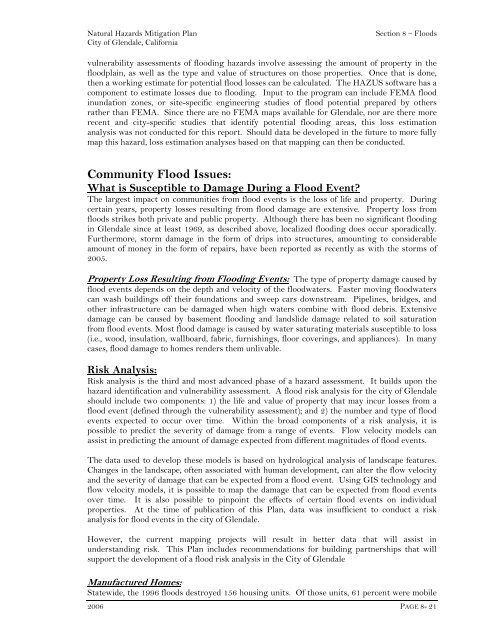Glendale (PDF) - Hazard Mitigation Web Portal - State of California
Glendale (PDF) - Hazard Mitigation Web Portal - State of California
Glendale (PDF) - Hazard Mitigation Web Portal - State of California
- No tags were found...
Create successful ePaper yourself
Turn your PDF publications into a flip-book with our unique Google optimized e-Paper software.
Natural <strong>Hazard</strong>s <strong>Mitigation</strong> PlanCity <strong>of</strong> <strong>Glendale</strong>, <strong>California</strong>Section 8 – Floodsvulnerability assessments <strong>of</strong> flooding hazards involve assessing the amount <strong>of</strong> property in thefloodplain, as well as the type and value <strong>of</strong> structures on those properties. Once that is done,then a working estimate for potential flood losses can be calculated. The HAZUS s<strong>of</strong>tware has acomponent to estimate losses due to flooding. Input to the program can include FEMA floodinundation zones, or site-specific engineering studies <strong>of</strong> flood potential prepared by othersrather than FEMA. Since there are no FEMA maps available for <strong>Glendale</strong>, nor are there morerecent and city-specific studies that identify potential flooding areas, this loss estimationanalysis was not conducted for this report. Should data be developed in the future to more fullymap this hazard, loss estimation analyses based on that mapping can then be conducted.Community Flood Issues:What is Susceptible to Damage During a Flood Event?The largest impact on communities from flood events is the loss <strong>of</strong> life and property. Duringcertain years, property losses resulting from flood damage are extensive. Property loss fromfloods strikes both private and public property. Although there has been no significant floodingin <strong>Glendale</strong> since at least 1969, as described above, localized flooding does occur sporadically.Furthermore, storm damage in the form <strong>of</strong> drips into structures, amounting to considerableamount <strong>of</strong> money in the form <strong>of</strong> repairs, have been reported as recently as with the storms <strong>of</strong>2005.Property Loss Resulting from Flooding Events: The type <strong>of</strong> property damage caused byflood events depends on the depth and velocity <strong>of</strong> the floodwaters. Faster moving floodwaterscan wash buildings <strong>of</strong>f their foundations and sweep cars downstream. Pipelines, bridges, andother infrastructure can be damaged when high waters combine with flood debris. Extensivedamage can be caused by basement flooding and landslide damage related to soil saturationfrom flood events. Most flood damage is caused by water saturating materials susceptible to loss(i.e., wood, insulation, wallboard, fabric, furnishings, floor coverings, and appliances). In manycases, flood damage to homes renders them unlivable.Risk Analysis:Risk analysis is the third and most advanced phase <strong>of</strong> a hazard assessment. It builds upon thehazard identification and vulnerability assessment. A flood risk analysis for the city <strong>of</strong> <strong>Glendale</strong>should include two components: 1) the life and value <strong>of</strong> property that may incur losses from aflood event (defined through the vulnerability assessment); and 2) the number and type <strong>of</strong> floodevents expected to occur over time. Within the broad components <strong>of</strong> a risk analysis, it ispossible to predict the severity <strong>of</strong> damage from a range <strong>of</strong> events. Flow velocity models canassist in predicting the amount <strong>of</strong> damage expected from different magnitudes <strong>of</strong> flood events.The data used to develop these models is based on hydrological analysis <strong>of</strong> landscape features.Changes in the landscape, <strong>of</strong>ten associated with human development, can alter the flow velocityand the severity <strong>of</strong> damage that can be expected from a flood event. Using GIS technology andflow velocity models, it is possible to map the damage that can be expected from flood eventsover time. It is also possible to pinpoint the effects <strong>of</strong> certain flood events on individualproperties. At the time <strong>of</strong> publication <strong>of</strong> this Plan, data was insufficient to conduct a riskanalysis for flood events in the city <strong>of</strong> <strong>Glendale</strong>.However, the current mapping projects will result in better data that will assist inunderstanding risk. This Plan includes recommendations for building partnerships that willsupport the development <strong>of</strong> a flood risk analysis in the City <strong>of</strong> <strong>Glendale</strong>Manufactured Homes:<strong>State</strong>wide, the 1996 floods destroyed 156 housing units. Of those units, 61 percent were mobile2006 PAGE 8- 21
















